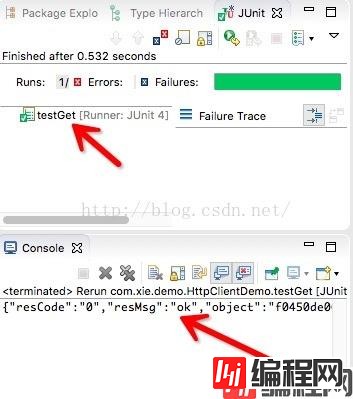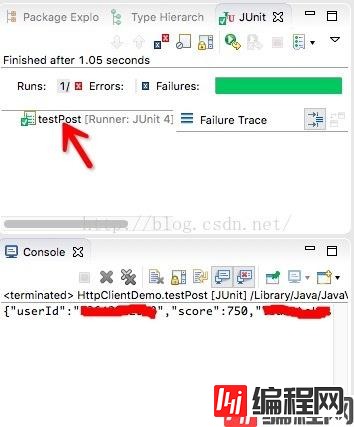Python 官方文档:入门教程 => 点击学习
目录Httpclient封装post请求和get的请求httpclient的post和get请求所用的代码HttpClient发送Get、Post请求的实践1. 配置及实例化Http
在我们程序员生涯中,经常要复用代码,所以我们应该养成时常整理代码的好习惯,以下是我之前封装的
package com.marco.common;
import java.io.BufferedReader;
import java.io.IOException;
import java.io.InputStreamReader;
import java.net.URI;
import java.util.ArrayList;
import java.util.Iterator;
import java.util.List;
import java.util.Map;
import org.apache.http.HttpEntity;
import org.apache.http.HttpResponse;
import org.apache.http.httpstatus;
import org.apache.http.NameValuePair;
import org.apache.http.StatusLine;
import org.apache.http.client.HttpClient;
import org.apache.http.client.entity.UrlEncodedFORMEntity;
import org.apache.http.client.methods.CloseableHttpResponse;
import org.apache.http.client.methods.HttpGet;
import org.apache.http.client.methods.HttpPost;
import org.apache.http.entity.StringEntity;
import org.apache.http.impl.client.CloseableHttpClient;
import org.apache.http.impl.client.DefaultHttpClient;
import org.apache.http.impl.client.HttpClients;
import org.apache.http.message.BasicNameValuePair;
import org.apache.http.protocol.HTTP;
import org.apache.http.util.EntityUtils;
import org.apache.log4j.Logger;
public class HttpUtil {
private static Logger logger = Logger.getLogger(HttpUtil.class);
public static String doGet(String url) {
try {
HttpClient client = new DefaultHttpClient();
//发送get请求
HttpGet request = new HttpGet(url);
HttpResponse response = client.execute(request);
if (response.getStatusLine().getStatusCode() == HttpStatus.SC_OK) {
String strResult = EntityUtils.toString(response.getEntity());
return strResult;
}
}
catch (IOException e) {
e.printStackTrace();
}
return null;
}
public static String doPost(String url, Map params){
BufferedReader in = null;
try {
// 定义HttpClient
HttpClient client = new DefaultHttpClient();
// 实例化HTTP方法
HttpPost request = new HttpPost();
request.setURI(new URI(url));
//设置参数
List<NameValuePair> nvps = new ArrayList<NameValuePair>();
for (Iterator iter = params.keySet().iterator(); iter.hasNext();) {
String name = (String) iter.next();
String value = String.valueOf(params.get(name));
nvps.add(new BasicNameValuePair(name, value));
//System.out.println(name +"-"+value);
}
request.setEntity(new UrlEncodedFormEntity(nvps,HTTP.UTF_8));
HttpResponse response = client.execute(request);
int code = response.getStatusLine().getStatusCode();
if(code == 200){ //请求成功
in = new BufferedReader(new InputStreamReader(response.getEntity()
.getContent(),"utf-8"));
StringBuffer sb = new StringBuffer("");
String line = "";
String NL = System.getProperty("line.separator");
while ((line = in.readLine()) != null) {
sb.append(line + NL);
}
in.close();
return sb.toString();
}
else{ //
System.out.println("状态码:" + code);
return null;
}
}
catch(Exception e){
e.printStackTrace();
return null;
}
}
public static String doPost(String url, String params) throws Exception {
CloseableHttpClient httpclient = HttpClients.createDefault();
HttpPost httpPost = new HttpPost(url);// 创建httpPost
httpPost.setHeader("Accept", "application/JSON");
httpPost.setHeader("Content-Type", "application/json");
String charSet = "UTF-8";
StringEntity entity = new StringEntity(params, charSet);
httpPost.setEntity(entity);
CloseableHttpResponse response = null;
try {
response = httpclient.execute(httpPost);
StatusLine status = response.getStatusLine();
int state = status.getStatusCode();
if (state == HttpStatus.SC_OK) {
HttpEntity responseEntity = response.getEntity();
String jsonString = EntityUtils.toString(responseEntity);
return jsonString;
}
else{
logger.error("请求返回:"+state+"("+url+")");
}
}
finally {
if (response != null) {
try {
response.close();
} catch (IOException e) {
e.printStackTrace();
}
}
try {
httpclient.close();
} catch (IOException e) {
e.printStackTrace();
}
}
return null;
}
}httpclient是一个非常常用的工具,在项目开发的时候,经常需要请求第三方的接口,我整理好了这段代码,以后回头找的时候就方便啦!
private static final CloseableHttpClient httpclient;
public static final String CHARSET = "UTF-8";
static{
RequestConfig config = RequestConfig.custom().setConnectTimeout(5000).setSocketTimeout(3000).build();
httpclient = HttpClientBuilder.create().setDefaultRequestConfig(config).build();
}
public static String sendGet(String url, Map<String, Object> params) throws ParseException, UnsupportedEncodingException, IOException{
if(params !=null && !params.isEmpty()){
List<NameValuePair> pairs = new ArrayList<NameValuePair>(params.size());
for (String key :params.keySet()){
pairs.add(new BasicNameValuePair(key, params.get(key).toString()));
}
url +="?"+EntityUtils.toString(new UrlEncodedFormEntity(pairs), CHARSET);
}
HttpGet httpGet = new HttpGet(url);
CloseableHttpResponse response = httpclient.execute(httpGet);
int statusCode = response.getStatusLine().getStatusCode();
if(statusCode !=200){
httpGet.abort();
throw new RuntimeException("HttpClient,error status code :" + statusCode);
}
HttpEntity entity = response.getEntity();
String result = null;
if (entity != null) {
result = EntityUtils.toString(entity, "utf-8");
EntityUtils.consume(entity);
response.close();
return result;
}else{
return null;
}
}
public static String sendPost(String url, Map<String, Object> params) throws ClientProtocolException, IOException {
List<NameValuePair> pairs = null;
if (params != null && !params.isEmpty()) {
pairs = new ArrayList<NameValuePair>(params.size());
for (String key : params.keySet()) {
pairs.add(new BasicNameValuePair(key, params.get(key).toString()));
}
}
HttpPost httpPost = new HttpPost(url);
if (pairs != null && pairs.size() > 0) {
httpPost.setEntity(new UrlEncodedFormEntity(pairs, CHARSET));
}
CloseableHttpResponse response = httpclient.execute(httpPost);
int statusCode = response.getStatusLine().getStatusCode();
if (statusCode != 200) {
httpPost.abort();
throw new RuntimeException("HttpClient,error status code :" + statusCode);
}
HttpEntity entity = response.getEntity();
String result = null;
if (entity != null) {
result = EntityUtils.toString(entity, "utf-8");
EntityUtils.consume(entity);
response.close();
return result;
}else{
return null;
}
}4.1 测试Get方法,e .g:
@Test
public void testGet() throws ParseException, UnsupportedEncodingException, IOException {
String testUrl01 = "具体的测试接口地址";
Map<String, Object> params01 = new HashMap<>();
params01.put("参数01", "对应的参数取值");
params01.put("参数02", "对应的参数取值");
System.out.println(sendGet(testUrl01, params01));
}
4.2 测试Post方法,e.g:
@Test
public void testPost() throws ClientProtocolException, IOException {
String testUrl02 = "具体的测试接口地址";
Map<String, Object> params02 = new HashMap<>();
params02.put("参数01", "对应的参数取值");
params02.put("参数02", "对应的参数取值");
System.out.println(sendPost(testUrl02, params02));
}
以上为个人经验,希望能给大家一个参考,也希望大家多多支持编程网。
--结束END--
本文标题: java中httpclient封装post请求和get的请求实例
本文链接: https://www.lsjlt.com/news/155824.html(转载时请注明来源链接)
有问题或投稿请发送至: 邮箱/279061341@qq.com QQ/279061341
下载Word文档到电脑,方便收藏和打印~
2024-03-01
2024-03-01
2024-03-01
2024-02-29
2024-02-29
2024-02-29
2024-02-29
2024-02-29
2024-02-29
2024-02-29
回答
回答
回答
回答
回答
回答
回答
回答
回答
回答
0